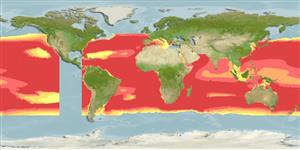Common names from other countries
>
Myctophiformes (Lanternfishes) >
Myctophidae (Lanternfishes) > Myctophinae
Etymology: Diogenichthys: Taken from Diogenes, cinic philosopher who showed his comptent for the amenities of life by living in a tube, 1802 + Greek, ichthys = fish (Ref. 45335).
Environment: milieu / climate zone / depth range / distribution range
Ekologi
laut batipelagis; oceanodromus (Ref. 51243); kisaran kedalaman 0 - 1050 m (Ref. 4479). Deep-water; 50°N - 48°S, 82°W - 109°W
Atlantic Ocean: widely but unevenly distributed between 50°N and 48°S, less abundant or absent in regions of low productivity. Western Indian Ocean: between 22°S and 45°S. Pacific Ocean: widespread uneven distribution between 35°N and 25°S. South China Sea (Ref.74511).
Length at first maturity / Size / Weight / umur
Maturity: Lm ?, range 2 - ? cm
Max length : 2.9 cm SL jantan/; (Ref. 4479)
Duri punggung (Keseluruhan (total)) : 0; duri punggung lunak (Keseluruhan (total)) : 10 - 12; Duri dubur: 0; Sirip dubur lunak: 15 - 18.
Oceanic, epipelagic to mesopelagic (Ref. 4066, 58302), found between 400-930 m during the day and between 18-1,050 m at night (with maximum abundance at 50-100 m and 500-700 m at night) (Ref. 4479). Larvae and juveniles non-migratory at least near the Canary Islands (Ref. 4479). Oviparous, with planktonic eggs and larvae (Ref. 31442). Minimum depth from Ref. 58018.
Hulley, P.A., 1990. Myctophidae. p. 398-467. In J.C. Quero, J.C. Hureau, C. Karrer, A. Post and L. Saldanha (eds.) Check-list of the fishes of the eastern tropical Atlantic (CLOFETA). JNICT, Lisbon; SEI; Paris; and UNESCO, Paris. Vol. 1. (Ref. 4479)
Status IUCN Red List (Ref. 130435)
CITES (Ref. 128078)
Not Evaluated
ancaman kepada manusia
Harmless
penggunaan manusia
Alat, peralatan
laporan khas
muat turun XML
Sumber internet
Estimates based on models
Preferred temperature (Ref.
115969): 8 - 20.6, mean 13.4 (based on 1072 cells).
Phylogenetic diversity index (Ref.
82804): PD
50 = 0.6250 [Uniqueness, from 0.5 = low to 2.0 = high].
Bayesian length-weight: a=0.00692 (0.00297 - 0.01609), b=3.13 (2.93 - 3.33), in cm Total Length, based on LWR estimates for this (Sub)family-body shape (Ref.
93245).
Trophic level (Ref.
69278): 3.1 ±0.25 se; based on food items.
Daya lenting (Ref.
120179): Tinggi, Waktu penggandaan populasi minimum kurang dari 15 bulan (Preliminary K or Fecundity.).
Fishing Vulnerability (Ref.
59153): Low vulnerability (10 of 100).
